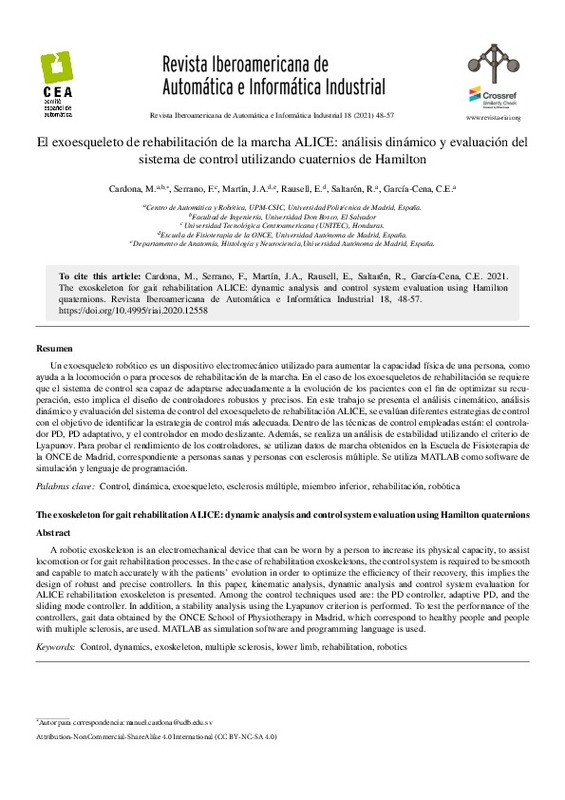Abolvafaei, M., Ganjefar, S., 2019. Maximum power extraction from a wind turbine using second-order fast terminal sliding mode control. Renewable Energy 139, 1437 - 1446. https://doi.org/10.1016/j.renene.2019.03.044
Arnold, E. M., Ward, S. R., Lieber, R. L., Delp, S. L., 2010. A model of the lower limb for analysis of human movement.
Cardona, M., Destarac, M. A., García, C. E., Nov 2017. Exoskeleton robots for rehabilitation: State of the art and future trends. In: 2017 IEEE 37th Central America and Panama Convention (CONCAPAN XXXVII). pp. 1-6. https://doi.org/10.1109/CONCAPAN.2017.8278480
[+]
Abolvafaei, M., Ganjefar, S., 2019. Maximum power extraction from a wind turbine using second-order fast terminal sliding mode control. Renewable Energy 139, 1437 - 1446. https://doi.org/10.1016/j.renene.2019.03.044
Arnold, E. M., Ward, S. R., Lieber, R. L., Delp, S. L., 2010. A model of the lower limb for analysis of human movement.
Cardona, M., Destarac, M. A., García, C. E., Nov 2017. Exoskeleton robots for rehabilitation: State of the art and future trends. In: 2017 IEEE 37th Central America and Panama Convention (CONCAPAN XXXVII). pp. 1-6. https://doi.org/10.1109/CONCAPAN.2017.8278480
Cardona, M., García Cena, C. E., 2019a. Biomechanical analysis of the lower limb: A full-body musculoskeletal model for muscle-driven simulation. IEEE Access 7, 92709-92723. https://doi.org/10.1109/ACCESS.2019.2927515
Cardona, M., García Cena, C. E., October 2019b. Musculoskeletal modeling as a tool for biomechanical analysis of normal and pathological gait. VIII Latin American Conference on Biomedical Engineering and XLII National Conference on Biomedical Engineering. CLAIB 2019. IFMBE Proceedings, Springer 75, 955-963. https://doi.org/10.1007/978-3-030-30648-9_124
Chong, L., Jianfeng, S., Linhong, J., 2013. Lower limb rehabilitation robots: A review. In: World Congress on Medical Physics and Biomedical Engineering. IFMBE Proceedings. Vol. 39. p. 2042-2045. https://doi.org/10.1007/978-3-642-29305-4_536
Eker, I., 2010. Second-order sliding mode control with experimental application. ISA Transactions 49 (3), 394 - 405. https://doi.org/10.1016/j.isatra.2010.03.010
He, W., Li, Z., Dong, Y., Zhao, T., Jan 2019. Design and adaptive control for an upper limb robotic exoskeleton in presence of input saturation. IEEE Transactions on Neural Networks and Learning Systems 30 (1), 97-108. DOI: 10.1109/TNNLS.2018.2828813 https://doi.org/10.1109/TNNLS.2018.2828813
Kapandji, A., 2010. Fisiología Articular, 6th Edition. Vol. 2. Editorial Panamericana, France.
Maciejasz, P., Eschweiler, J., Gerlach-Hahn, K., et.al., 2014. "A survey on robotic devices for upper limb rehabilitation". https://doi.org/10.1186/1743-0003-11-3
Proietti, T., Jarrasse, N., Roby-Brami, A., Morel, G., April 2015. Adaptive control of a robotic exoskeleton for neurorehabilitation. In: 2015 7th International IEEE/EMBS Conference on Neural Engineering (NER). pp. 803-806. https://doi.org/10.1109/NER.2015.7146745
Reinkensmeyer, D. J., 2003. How to retrain movement after neurologic injury: a computational rationale for incorporating robot (or therapist) assistance. In: Proceedings of the 25th Annual International Conference of the IEEE Engineering in Medicine and Biology Society (IEEE Cat. No.03CH37439). Vol. 2. pp. 1479-1482 Vol.2.
Reinkensmeyer, D. J., Aoyagi, D., Emken, J., Galvez, J., Ichinose W, W., etal, Aug-Sep 2006. Tools for understanding and optimizing robotic gait training. J Rehabil Res Dev 43 (5), 657-70. https://doi.org/10.1682/JRRD.2005.04.0073
Riener, R., Guidali, M., Keller, U., Duschau-Wicke, A., et.al., 2014. "a survey on robotic devices for upper limb rehabilitation".
Serrano, F. E., Rossell, J. M., 2015. Complete kinematic analysis of the stewartgough platform by unit quaternions. Mechanics and Control (Vol, 34, no. 4), 59-69.
Spong, M., Hutchinson, S., Vidyasagar, M., 2006. Robot Modeling and Control. John Wiley and Sons.
Wang, J.-Y., Liang, H.-Z., Sun, Z.-W., Wu, S.-N., Zhang, S.-J., 2013. Relative motion coupled control based on dual quaternion. Aerospace Science and Technology 25 (1), 102 - 113. https://doi.org/10.1016/j.ast.2011.12.013
Wu, Q., Chen, B., Wu, H., 2019. Rbfn-based adaptive backstepping sliding mode control of an upper-limb exoskeleton with dynamic uncertainties. IEEE Access 7, 134635-134646. https://doi.org/10.1109/ACCESS.2019.2941973
Yakub, F., Khudzari, A., Mori, Y., March 2014. "recent trends for practical rehabilitation robotics, current challenges and the future". https://doi.org/10.1097/MRR.0000000000000035
Yang, Z., Zhu, Y., Yang, X., Zhang, Y., Aug 2009. Impedance control of exoskeleton suit based on adaptive rbf neural network. In: 2009 International Conference on Intelligent Human-Machine Systems and Cybernetics. Vol. 1. pp. 182-187. https://doi.org/10.1109/IHMSC.2009.54
Zhou, W., Chen, W., Liu, H., Li, X., 2015. A new forward kinematic algorithm for a general stewart platform. Mechanism and Machine Theory 87, 177 - 190. https://doi.org/10.1016/j.mechmachtheory.2015.01.002
Özgur, E., Mezouar, Y., 2016. Kinematic modeling and control of a robot arm ¨ using unit dual quaternions. Robotics and Autonomous Systems 77, 66 - 73. https://doi.org/10.1016/j.robot.2015.12.005
Ilyas Eker, 2010. Second-order sliding mode control with experimental application. ISA Transactions 49 (3), 394 - 405. https://doi.org/10.1016/j.isatra.2010.03.010
[-]









